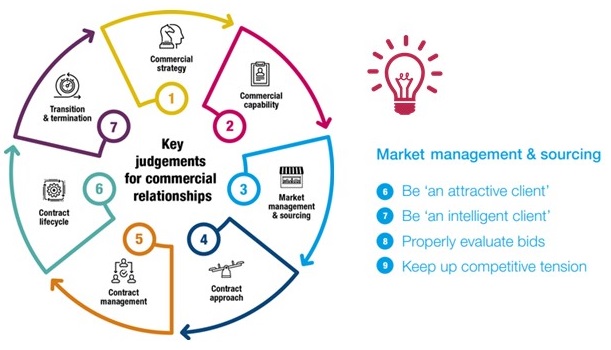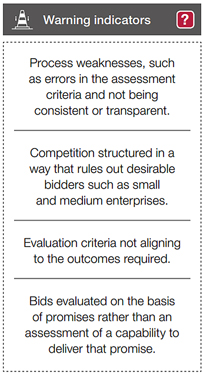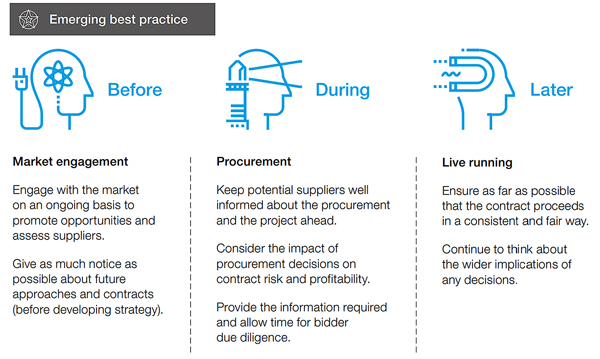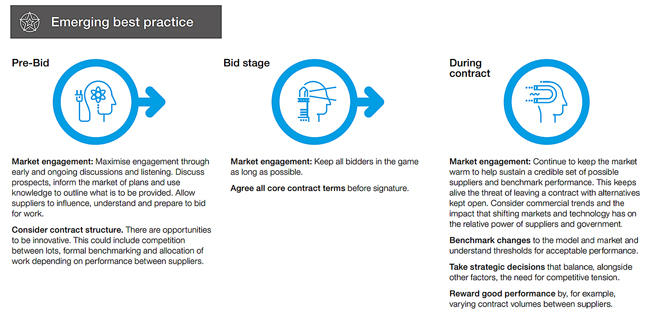Establishing solid foundations early in the contract and commercial relationship lifecycle is critical for contracts to work. But this process starts long before contracts are signed. Two recent NAO reports provide insights into the importance of getting both the procurement strategy and process right. Experience has shown that not doing so can result in millions of pounds in legal costs – £100 million in one recent case – or an uncompetitive contract leading to additional costs. This latest blog in our commercial and contract management series shares our recent insights across the market management and sourcing domain of our contracts lifecycle.
Our November 2016 report, Commercial and contract management – insights and emerging best practice sets out 20 areas of insights into good practice. Four relate to ‘market management and sourcing’, as illustrated, including considering whether contracts represent a fair deal for contractors and are achievable.

Our two latest reports relating to commercial and contract management:
 The Nuclear Decommissioning Authority’s (NDA) Magnox contract report considers the competitive procurement exercise for services to decommission two nuclear research sites and 10 sites comprising power stations that near or at the end of their operational life. The NDA awarded a 14-year contract, with an estimated value of up to £6.2 billion, one of the biggest government contracts ever put out to tender.
The Nuclear Decommissioning Authority’s (NDA) Magnox contract report considers the competitive procurement exercise for services to decommission two nuclear research sites and 10 sites comprising power stations that near or at the end of their operational life. The NDA awarded a 14-year contract, with an estimated value of up to £6.2 billion, one of the biggest government contracts ever put out to tender.
 Improving value for money in the non-competitive procurement of defence equipment: Given the inherent lack of competition across some defence areas, in 2014 the Ministry of Defence (MoD) introduced the Single Source Contract Regulations to provide better value for money for the taxpayer. The Regulations offer considerable opportunities to improve contract management.
Improving value for money in the non-competitive procurement of defence equipment: Given the inherent lack of competition across some defence areas, in 2014 the Ministry of Defence (MoD) introduced the Single Source Contract Regulations to provide better value for money for the taxpayer. The Regulations offer considerable opportunities to improve contract management.
These reports shed further light on the four market monitoring and sourcing insights …
Insight 7: ‘Be an intelligent client’
Far too often we see government expose itself to risk as it does not understand what it means to buy and what it should cost. Our recent NDA report reiterates the need for government to get independent assurance of its assumptions about the work it needs contractors to undertake. By March 2017 the NDA’s estimate of decommissioning costs had risen to £6.0 billion, compared to a winning bid of £3.8 billion. The NDA did not know if these increases related to underperformance by the previous contractor or NDA’s over-optimistic assumptions about the state of the sites when it tendered the contract. Subsequent costs were more than its contingency estimate for extra scope.
We have continually seen insufficient due diligence undermining contracts. For example, for its Health and Disability Assessments contracts, the Department for Work & Pensions continued to set unrealistically high targets and use assumptions without sufficient evidence or challenge.
Part of being an intelligent client is having accurate data on contracts, as well as on requirements that government wants to be provided. We found that a lack of good quality data on the MoD’s portfolio of non-competitive contracts created challenges for MoD in achieving savings. For example, as its contract database contained out-of-date information, the MoD struggled to identify the contracts due for renewal or amendment and that may fall within the scope of the Single Source Contract Regulations.
Insight 8: ‘Properly evaluate bids’
 Very few procurements are legally challenged. But we have recently seen a handful of examples where procurement has gone very wrong. And when it does, this has a significant impact on value for money. As described in our report, the recent ‘Magnox contract’ provides a startling lesson and reinforces the warning indicators we identified in our insights report (see right). In particular, it showed the need to create an understandable evaluation process, which could be easily applied with the right balance of criteria.
Very few procurements are legally challenged. But we have recently seen a handful of examples where procurement has gone very wrong. And when it does, this has a significant impact on value for money. As described in our report, the recent ‘Magnox contract’ provides a startling lesson and reinforces the warning indicators we identified in our insights report (see right). In particular, it showed the need to create an understandable evaluation process, which could be easily applied with the right balance of criteria.
In particular, following a legal challenge by an unsuccessful bidder in 2016, the High Court found that the NDA had not correctly applied pass/fail threshold requirements. These requirements excluded bidders from the competition if they failed to include specific details in their bid. The Court found that if the NDA had applied its evaluation criteria correctly, the winning bidder would have been excluded from the competition. The NDA agreed to settle damage claims with the unsuccessful bidder leading to a £97.3 million settlement and a £122 million cost to the taxpayer, including legal fees.
Insight 6: ‘Be an attractive client’
We often find that government does not approach contracts enough as a two-way process, and they do not think about the impact of their decisions on market sustainability and contractors’ views of government. The MOD’s reforms to non-competitive contracts partly aim to ensure that suppliers are paid a fair and reasonable price. It has worked with industry to determine the extent to which its work impacts on the financial health of suppliers. This is an important consideration in agreeing profit rates, alongside making savings where possible.
More widely, for suppliers to want to work with government, they need to have confidence that they will be treated fairly and that processes and contracts will run as expected. Court cases, legal costs and a failure to apply expected processes, such as with the NDA Magnox contract, will undoubtedly have a wider impact on the attractiveness of working with government to suppliers.

Insight 9: ‘Keep up competitive tension’
Commercial and contract management – insights and emerging best practice emphasises that competition can be taken further than assuring there are enough credible bidders in the procurement process – we touched on alternative approaches, such as where the market is insufficiently competitive.
Our previous post also considered the importance of keeping up competitive tension, as illustrated by the BBC’s work to sustain market competition for its television licence fee collection contract. Demonstrating the health of the market helps to increase the pressure on a supplier to provide a good service.
Our recent non-competitive procurement report describes how, given the MoD’s unique position and the challenges in ensuring competitive tension, the MoD needs to take a more strategic approach to encourage competition. The government has created the Single Source Regulations Office, which addresses a lack of competitive tension in many large defence contracts by: recommending the profit rate for contracts; producing guidance on the types of costs are permitted within the contract price; and issuing opinions or determinations where a disagreement on costs cannot be settled through negotiation. More widely, the Single Source Contract Regulations greatly expand the requirement for suppliers to be fully transparent in their bid costs. This builds on previous NAO work on open book accounting.
Through introducing the Single Source Regulations Office, the MoD expects to generate £1.7 billion of savings over the 10-year Equipment Plan.

We will continue sharing insights from our work. We welcome your comments and invite you to contact us to discuss any of these issues in more detail. Please do sign-up to receive email alerts on future blogs to keep up-to-speed with our emerging thinking.



